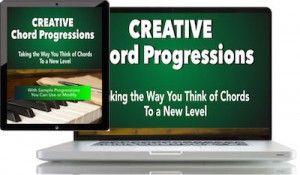First, a Bit of Basic Theory…
For any given major key, there are 7 chords that occur naturally, one built on each note of the scale. In the key of C major, that gives you these chords:
- C
- Dm
- Em
- F
- G
- Am
- Bdim
According to the very popular HookTheory website, the 3 most commonly used chords in that list are, in order, G (V), F (IV), and C (I). When you hear about the standard 3-chord song, those are the chords you’ll most often find being used.
Beyond those 3, the next most popular chords are: Am (vi), Dm (ii) and Em (iii). That leaves Bdim (vii) as the least-used chord out of the 7 that naturally occur in the key of C major.
Introducing Flat-III, Flat-VI, and Flat-VII
As you likely know, it’s relatively common for a songwriter to use chords that don’t naturally exist in a key’s allotment of 7 chords. That keeps things interesting, and helps as a writer seeks to shape the mood of the music.
 Looking for a way to make your chord progressions stand out a bit more, and get a little more attention? You need “Creative Chord Progressions.” Right now, this eBook is FREE of charge when you purchase the 10-eBook Bundle. Eleven songwriting eBooks for $37 USD, immediate download.
Looking for a way to make your chord progressions stand out a bit more, and get a little more attention? You need “Creative Chord Progressions.” Right now, this eBook is FREE of charge when you purchase the 10-eBook Bundle. Eleven songwriting eBooks for $37 USD, immediate download.
Most of these so-called non-diatonic chords fall into different categories such as secondary dominants, modal mixtures, various types of pre-dominant chords, just to name a few. The chords that we’re looking at today in this post, the bIII, bVI, and bVII, are all a type of modal mixture, which simply means that you’d find them in the key of C minor, and they’re “borrowed” and used in the key of C major.
Creating these chords is easy enough. To make a bIII chord, find the 3rd note of C major (E), lower it one semitone (Eb), and build a major chord on top of it (Eb-G-Bb). Do the same thing to make a bVI (Ab-C-Eb) and bVII (Bb-D-F).
Using Flat-III, Flat-VI, and Flat-VII
For any chord to sound good, you have to approach it and then leave it in a way that sounds right. Sometimes the best way is to demonstrate this with a few examples, so check out these ideas. (The letter b in front of a Roman numeral indicates “flat”):
Progressions That Use bIII:
- bIII usually moves easily to IV: C Eb F G
- bIII can move easily to bVI: C Eb Ab G
- bIII can move easily to bVII: C Eb Bb F
Progressions That Use bVI:
- bVI can move easily to V: C Am Ab G
- bVI can move easily to I: C Am Ab C/G G C
- bVI can move easily to bVII: C F Dm G Ab Bb C
Progressions That Use bVII:
- bVII can move easily to I: C F Bb C
- bVII can move easily to IV: C Dm G Bb F G C
- bVII can move easily to bIII, as part of a circle of 5ths: C F Bb Eb Dm G C
It’s very important to keep your eye on the bass line that non-diatonic chord like these ones create. It is the bass line that makes a progression sound good or bad. In general, moving stepwise into or away from a non-diatonic chord (i.e., Eb to F) or moving by a 4th or 5th (Eb-Ab, or Eb-Bb) will almost always work.
 Written by Gary Ewer. Follow Gary on Twitter
Written by Gary Ewer. Follow Gary on Twitter
 Thousands of songwriters are now using “The Essential Secrets of Songwriting” eBooks to polish their technique and improve their songwriting skills. Get a free eBook, “Creative Chord Progressions” if you buy the bundle today.
Thousands of songwriters are now using “The Essential Secrets of Songwriting” eBooks to polish their technique and improve their songwriting skills. Get a free eBook, “Creative Chord Progressions” if you buy the bundle today.











Thanks! My band mates and I are learning the song That Train Don’t Stop Here Anymore by Los Lobos and I was going nuts trying to figure out why the solo section goes to an Eb7 chord, then F and G when the song is in the key of C. I kept going back to my trusty chord wheel and thinking “Why isn’t this part in Em or at least E7??”
Now I get it; that solo section is meant to build some tension and sound different / funky. So it drops down to a flat third Eb to make the guitar shredding really pop before resolving back into the next verse by way of the four (F) and five (G) chords. They found a great way to modify the expected blues form and give it a “wow” moment. Really cool to understand why it works.
I’m learning a lot from this site. Thanks Gary!
Hi Gary, I have followed your blog for some years so thankyou for the lessons. A thought that I have had recently is “what actually inspires the use of non-key notes? Taking right from the point of view of the songwriter, – why do they even sing non-key notes in a melody?
What are they trying to express that the standard key itself can’t express? I was recently learning a Madonna song and I noticed that the out of key notes sounded slightly like “grumbling” a kind of emotion maybe not covered by key notes? It needed a non key note to express it. It was purposely flat to express the grumbling maybe?
I think I have kind of fallen in the trap of regarding everything as needing to be in-key but all the time there are non-key notes and these express important emotions or meanings in the song.
I think examining it right from the point of view of originally expressing the emotion or meaning might help to open up how & why non-key notes and chords are used?
Thankyou.
Hi Steve:
Using non-diatonic notes in melodies is a great way to create moods, as you’ve noticed in the Madonna song you’ve mentioned. There are no rules as to when (or, in a way, even how) to use these non-diatonic notes. I think you’d find that most songwriters tend to use them instinctively.
In my view, you may be overly worried about this aspect of melody writing. Most of the world’s best songs don’t use non-key notes — everything comes from the one key that exists from beginning to end of the song. My advice would be, if you hear a non-key note that you find interesting, try to figure out what the note is, what the chord that’s accompanying it is, and then use it if you like the affect. Beyond that, there really are no rules about their use.
-Gary
Hi Gary, thanks very much for your reply. Yes I see, instinct and mood is probably what I was looking for there, thanks!
I think we tend to naturally sing/write in diatonic notes as you said, but then maybe we can add other ones (if at all) if it feels right maybe for what we are trying to say? I must admit at the moment I mostly play along to other songs on guitar rather than actually writing. I guess this has come up for me in my attempts to transcribe as much as anything.
Anyway thanks again for your time.
I could not fit the bIII to iv into any scale or theory I had been taught. This introduced me to the concept of “non-diatonic” progressions. Thank you!!
Glad it helped, Ray.
-Gary
Pingback: Working Flat-III, Flat-VI, and Flat-VII Into a Major Progression - The Hit Songwriting Formula | The Hit Songwriting Formula